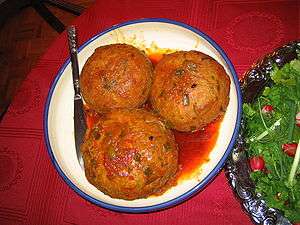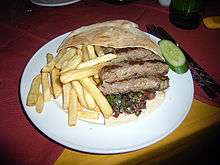Kofta




Kofta (see § Naming for other terms) is a family of meatball or meatloaf dishes found in South Asian, Middle Eastern, Balkan, and Central Asian cuisine. In the simplest form, koftas consist of balls of minced or ground meat—usually beef, chicken, lamb, or pork—mixed with spices and/or onions. In South Asia and the Middle East, koftas are usually made from lamb, beef, mutton or chicken, whereas Greek, Cypriot, and Balkan versions may use pork, beef, lamb, or mixture of the three. In India, vegetarian varieties include koftas made from potato, calabash, paneer, or banana. In Europe, kofta is served as fast food as a type of kebab.
Koftas in India are usually served cooked in a spicy curry/gravy and are eaten with boiled rice or a variety of Indian breads. In Iran, Iraq and Azerbaijan, koftas are served with a spiced gravy, as dry variations are considered to be kebabs. Shrimp and fish koftas are found in South India, West Bengal, some parts of the Persian Gulf, and parts of Egypt.
Variations
The meat is often mixed with other ingredients, such as rice, bulgur, vegetables, or eggs to form a smooth paste. They can be grilled, fried, steamed, poached, baked or marinated, and may be served with a rich spicy sauce. Koftas are sometimes made from fish or vegetables rather than red meat, especially in India; deep-fried kofta made from shrimp is known in Egypt.[1] Variations occur in North Africa, the Mediterranean, the Balkans, and India. According to a 2005 study done by a private food company, there were 291 different kinds of kofta in Turkey. [2] In the Arab world, kufta is usually shaped into cigar-shaped cylinders.
Early recipes (included in some of the earliest known Arabic cookbooks) generally concern seasoned lamb rolled into orange-sized balls, and glazed with egg yolk and sometimes saffron. This method was taken to the West and is referred to as "gilding" or "endoring". Many regional variations exist, notable among them include the unusually large Azerbaijani (Iranian) Tabriz kuftesi, having an average diameter of 20 cm, (8 in).[3] and may encase inside it an entire roasted chicken stuffed with dried fruits, nuts and boiled eggs!
In Central Asia, kofta is cooked with liberal amounts of tail fat.[4]
Koftas were introduced in South Asia following the Turkic conquests in the region, particularly by the Mughals. Koftas in South Asian cuisine are normally cooked in a spiced gravy, or curry, and sometimes simmered with hard-boiled eggs. Kofta dishes are very popular with immigrants from South Asia to the United Kingdom, and are widely available from many South Asian restaurants. Vegetarian koftas are eaten by a large population in India. The British dish Scotch egg may have been inspired by the Mughlai dish Nargisi kofta ("Narcissus kofta"[5]), where hard-boiled eggs are encased in a layer of spicy kofta meat.[6] In Bengal, a region of eastern India, koftas are made from prawns, fish, green bananas, cabbage or meat, such as minced goat meat. In Kashmir, mutton is often used in the preparation of koftas, as opposed to beef or lamb.
In Lebanon, kafta is usually prepared by mixing the ground beef with onion, parsley, allspice, black pepper and salt.[7]
In Morocco, kufta may be prepared in a tagine.
In Palestine, they are usually made of beef, chicken, lamb or a mixture of chicken and beef with allspice, parsley, mint, onion, black pepper and salt and are fried in olive oil or cooked in tomato or pomegranate stews. Israeli fish kufta is made of minced fish, coriander, dried peppers (bell peppers and chili peppers), onion, black pepper and salt and is usually cooked in a tomato stew with chickpeas or white beans.
In Pakistan, kofta is made from ground beef with onion, spices and salt. Nargisi kofta with hard boiled egg encased in spicy kofta are also popular.
In Greece and Cyprus, kofta is usually fried and eaten with tzatziki or yogurt.
In the Balkans, kofta is usually made from pork, beef or veal, or a mixture of the three. They are usually served as a meze with tarator.
In Albania, there are specialized shops called Qofteri, which offer qofte and beer.
In Romania, there is a local variety of kofta, known as chiftele or chiftea. They are usually made from minced pork, mixed with mashed potatoes and spices, then deep-fried. They are served with pilaf or mashed potatoes.
Naming
The origin of the word kofta comes from Classical Persian kōfta (کوفته), meaning "rissole", from the verb kōftan (کوفتن), "to pound" or "to grind", reflecting the ground meat used for the meatballs rather than chunks.[8]
- Afghanistan: کوفته (kofta)
- Albania: qofte
- Arab countries: كفته (kufta in standard Arabic and most dialects; kafta)
- Armenia: քյուֆթա (kyuft’a)
- Azerbaijan: küftə
- Bangladesh: kofta কোফতা Dhakayi Bangla or kufta কুফতা Sylheti Bangla
- Bosnia and Herzegovina: ćufte
- Bulgaria: кюфте (kyufte)
- Croatia: ćufta
- Georgia: გუფთა (gupta)
- Greece: κεφτές (keftés)
- Israel: כופתה (kufta)
- India: कोफ़्ता (kofta)
- Iran: کوفته (kufte)
- Kurdistan: کفته (kefta)
- Macedonia: ќофте (kjofte)
- Pakistan: كوفته (kofta)
- Romania: chiftea
- Serbia: ћуфтa (ćufta) or ћуфтe (ćufte)
- Slovenia: čufta
- Turkey: köfte
See also
References
- ↑ Abdel Fattah, Iman Adel (5 December 2013). "Bites Fil Beit: Koftet el Gambari – Shrimp kofta". Daily News Egypt. Retrieved 19 April 2015.
- ↑
- ↑ Oxford Companion to Food, s.v. kofta
- ↑ Jill Tilsley-Benham, ""Sheep with Two Tails: Sheep's Tail-Fat as Cooking Medium in the Middle East", In: Oxford Symposium on Food & Cookery, 1986: The Cooking Medium, p. 48
- ↑ "Nargisi meaning in Hindi - Meaning of NARGISI in Hindi - Translation". Dict.hinkhoj.com. Retrieved 2016-09-16.
- ↑ Oxford Companion to Food, s.v. kofta and Scotch egg
- ↑ "Basic Kafta Recipe by dianak". Retrieved 7 September 2016.
- ↑ Alan S. Kaye, "Persian loanwords in English", English Today 20:20-24 (2004), doi:10.1017/S0266078404004043.
External links
![]() The dictionary definition of kofta at Wiktionary
The dictionary definition of kofta at Wiktionary



